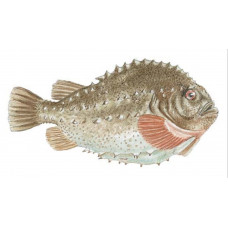Latin name
Cyclopterus lumpus
Other names
Lump, lumpsucker, nipisa, kiark-varrey; Italian: ciclottero; Spanish: cicloptero.
Identification
Lumpfish has a tall, thick body, but noticeably compressed from the sides, abdomen flattened. The head is relatively small, thick, almost cube-shaped. The fish has a warty appearance due to a ridge of prominent tubercles running along the middle of its back, as well as three other rows of tubercles on its sides, the upper of which extends from the tip of the snout to the base of the tail. Another distinctive feature is the fusion of the pelvic fins into a round suction disk that allows the fish to attach to rocks. The coloration of the fish is variable, usually olive green or bluish gray with a yellowish belly. In females, the body and fins are bluish green. In males, during spawning, the entire body becomes grayish-black in color and small silvery spots appear on the sides. The ventral surface, suction disc, unpaired and paired fins are colored in bright orange or crimson. The pectoral fins are broad and fan-shaped, with the lower rays beginning in the throat area. The first dorsal fin is visible only in young individuals.
Distribution
In the western Atlantic, the lumpfish is found from Hudson Bay to James Bay and from Labrador to New Jersey. It is rarely found from the Chesapeake Bay southward or near Bermuda. In the North Atlantic Ocean south to the Bay of Biscay in Europe and to the Chesapeake Bay on the coast of North America. Common in Hudson Bay, around Iceland and Greenland shores, as well as in the White Sea and Murmansk coast. Occurs near the Kanin Peninsula and occasionally eastward. Individual specimens have been recorded in the Kara Sea. It occurs in large numbers off the coast of Denmark and in the Baltic Sea up to the Gulf of Finland.
Habitat
Lumpfish usually live on the rocky bottom in cold waters, but may also be found among floating algae. Most of the year it stays in open waters away from shores, in spring and summer it forms aggregations and comes to shore in shallow waters for spawning. It is a bottom-dwelling or bottom-pelagic species, but has recently been found to inhabit the pelagic as well. Can, be found in algae thickets. Habitat depths range from 50 to 150 m. High buoyancy is achieved by the reduction of bone tissue in the skeleton, the presence of thick jelly-like subcutaneous tissue, low muscular density and low density of ovarian fluid. In shallow waters, it mainly sticks to rocky and stony bottoms with thickets of kelp. In the Baltic Sea, it is found on sandy soils. Occasionally, it is also found in strongly desalinized water near river mouths.
Size
Lumpfish can grow up to 2 feet and 21 pounds, although they are usually smaller. Length up to 61 cm, weight up to 9.5 kg. The average length is up to 40 cm. Commercial catches are dominated by males 15-25 cm long. The females are 30-35 cm. Life expectancy in the White Sea reaches 3-4 years for males and 4-5 years for females.
Life history and Behavior
The female can lay 20,000 or more eggs, which sink to the bottom and adhere. The male guards them until they hatch. Lumpfish are solitary, not schooling fish.
Food and feeding habits
Feeding has a pronounced seasonal character. Adults feed intensively in winter time, eating small fish, crustaceans, ctenophores, jellyfish, small crustaceans, polychaetes, fish larvae, etc. During the spawning approach, lumpfish stop feeding.
Reproduction
Spawning takes place in the Baltic Sea in January-April, off the coast of Iceland in April-March, off Greenland in April-June, off the coast of Finland in May-June, on the Murman in May-June, and in the White Sea in late May-July. The spawning period is greatly extended. Sexual dimorphism is pronounced: mature females are always larger than males; males have a developed urogenital papilla. During this period, males acquire mating coloration. About 20 min after spawning, the mating coloration disappears. Spawning shoals consist primarily of four-year-old males 17-25 cm long and five-year-old females 25-39 cm long. Spawning takes place near the shore, on stony areas with thickets of kelp, at a temperature of 5-8 °C and a salinity of 23-26%. Fertility is from 15 to 300 thousand eggs. Spawning occurs in batches. Within 10-15 days, the female lays eggs clumped together on rocks and among algae, brightly colored in yellow-orange to crimson-yellow. The diameter of the eggs is 1.2-2.6 mm in the North Sea and 2.4-2.7 mm in the White Sea. After spawning, females retreat to the depths, and males remain near the shore to protect the clutches for the entire period of egg development, lasting about two months. Fry 4-6 mm in length appear on the Murman in July-August and in the White Sea in the second half of August. By September, fry reach 20 mm in length and move a little deeper, but they spend the next summer near shore in kelp forests (juveniles 40-50 mm long), then they move at depths of 530-150 m and more, returning to shore only when they reach sexual maturity. Bony plaques on the body begin to appear in larvae 20-22 mm in length, and their formation ends at 40 mm in length.
| Classification | |
| Phylum | Chordata |
| Class | Actinopterygii |
| Squad | Scorpaeniformes |
| Family | Cyclopteridae |
| Genus | Cyclopterus |
| Species | C. lumpus |
| Features | |
| Conservation status | Near Threatened |
| Habitat | Pelagic |
| Life span, years | No information |
| Maximum body weight, kg | 9.5 |
| Maximum length, cm | 61 |
| Sailing speed, m/s | No information |
| Threat to people | Edible |
| Way of eating | Planktonophage |
Lumpfish
Tags: Lumpfish




